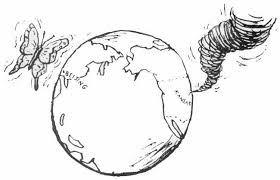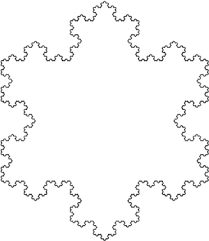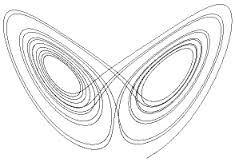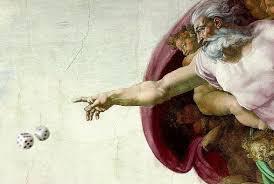Physicist Arthur Eddington said, “the Universe is not only stranger than we imagine, it’s stranger than we can imagine.”
Right off the bat are two possibilities: either it always existed, or had a beginning. Either one blows fuses in my brain. (Note: the God idea doesn’t help. The same problem applies to him.)

Mandelbrot
Which brings me to chaos.
Religionists imagine God organized creation from primordial chaos; in common parlance that word connotes a state of complete disorganization. But in science its meaning is more subtle, and much more interesting, as famously pioneered by mathematician Benoit Mandelbrot starting in the 1960s.
Take the weather. It can’t be forecasted very far because there are so many interacting factors; a tiny change in one cascades into ever bigger changes over time.

Mandelbrot posed the seemingly simple question: how long is Britain’s coastline? But it’s not so simple. Measuring it on a map of course can’t account for all the little crenellations. You could take a yardstick and walk the coast, getting a much more accurate answer.

Coastline irregularities are a kind of seemingly patternless phenomenon found throughout existence. But Mandelbrot’s startling discovery was that there is a pattern. The kind of coastal irregularities you see on a world map are exactly replicated when you focus on a smaller area. No matter how small.

Look at the illustration. No matter the scale, no matter how much you magnify, the pattern persists. If the picture reminds you of a snowflake, it should, because snowflake formation is a good example of the phenomenon.
Environmentalists romanticize a “balance of nature,” an ecosystem in harmonious equilibrium. It turns out no such thing exists. An ecosystem works like the weather, one small perturbation sending it on an unpredictable and quintessentially chaotic path.
Chaos can also affect a system close to your own heart. In fact, it is your heart. Its normally regular beating can sometimes become chaotic in the textbook sense. That calls for attention.

Shaw found that certain flow rates produced chaotic drips, with no regular intervals between them. Then all he did was measure those intervals and plot those numbers on a graph. Actually he used pairs of intervals to produce a graphing in three dimensions. Now, you might expect a truly random distribution, with the dots falling all over, patternlessly. But that’s not what Shaw found. The pattern of dots took on a distinct shape (“resembling loopy trails of smoke left by an out-of-control sky-writing plane”).

Strange attractor
A shape thusly revealed is called a “strange attractor.” I was puzzled by that term until I realized it’s as though the shape attracts the data points to itself, keeping them from falling elsewhere.
This is extremely weird. While the shape acts like a magnet for data points, of course a magnet is a physical object, but the “strange attractor” is not, it’s just a concept. So what is going on here? What makes the seemingly random, chaotic drip intervals form a certain distinct shape when graphed?

Of course not. Surely God wouldn’t bother to carefully regulate the dripping to produce the pattern. Yet it’s as if he did.
But why? That’s what I really wanted to understand. The book doesn’t tell me; Gleick writes as though the question never occurred to him. He even quotes John von Neumann: “The sciences do not try to explain, they hardly even try to interpret, they mainly make models . . . [which describe] observed phenomena.” In other words, science reveals what happens, but not why.
With all respect to the great von Neumann, I disagree. Why the Universe exists may be a meaningless question, but why Shaw’s faucet dripped the way it did is not. Another scientist Gleick quotes answered Einstein’s famous line by saying God does play dice with the Universe, and the dice are loaded; “the main objective of physics now is to find out by what rules were they loaded and how can we use them for our own ends.”

Science is humanity’s great quest for understanding. Through that understanding we can control our destiny. But that’s almost a mere side effect of the real motivation: we just want to know.
